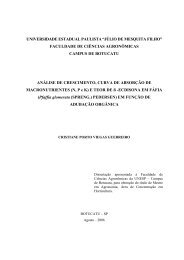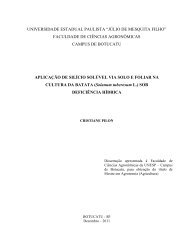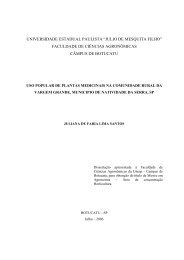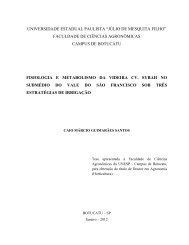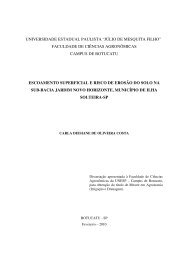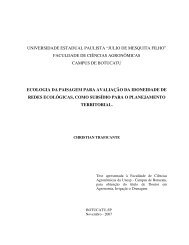CARACTERIZAÃÃO DO MECANISMO FOTOSSINTÃTICO E
CARACTERIZAÃÃO DO MECANISMO FOTOSSINTÃTICO E
CARACTERIZAÃÃO DO MECANISMO FOTOSSINTÃTICO E
Create successful ePaper yourself
Turn your PDF publications into a flip-book with our unique Google optimized e-Paper software.
3<br />
CHARACTERIZATION OF PHOTOSYNTHETIC MECHANISM AND THE<br />
FLOWERING ASPECTS OF Artemisia annua L. Botucatu, 2006. 68p. Tese<br />
(Doutorado em Agronomia/Horticultura) - Faculdade de Ciências Agronômicas,<br />
Universidade Estadual Paulista.<br />
Author: JOSÉ ABRAMO MARCHESE<br />
Adviser: FERNAN<strong>DO</strong> BROETTO<br />
Co-Adviser: RITA M. MORAES<br />
2 SUMMARY<br />
Leaves of Artemisia annua L. are a plentiful source of artemisinin, a<br />
drug with proven effectiveness against malaria. One of the objectives of this work was to<br />
identify the photosynthetic type of A. annua through studies of the carbon isotope composition<br />
(δ‰ 13 C) and the leaf anatomy. We also verified the growth and development of the CPQBA<br />
2/39x1V accession under moist subtropical climate. Two experiments were carried out in<br />
greenhouse using photoperiodic chambers. The plants were submitted to photoperiods of 7, 9,<br />
11, 13, 15 and 17 h, in two natural conditions of temperature: spring/summer (maximum of<br />
37ºC and minimum of 19ºC) and autumn/winter (maximum of 29ºC and minimum of 13ºC).<br />
Another experiment with different planting dates at field was carried out in Pato Branco, PR<br />
(26º11' S, 52º36' W and 760 m), Southern part of Brazil. The last experiment was the<br />
application of artemisinin (0, 500, 5000, and 10000 mg L -1 ) in A. annua plants to verify the<br />
role of the molecule on the flowering induction. A. annua presented a δ‰ 13 C = - 31.76 ± 0.07,<br />
what characterizes it as typical species with a C 3 photosynthetic mechanism, with an average<br />
of δ‰ 13 C = - 28, while C 4 species possess an average of δ‰ 13 C = - 14. The study of A. annua<br />
leaf anatomy confirms the results of δ‰ 13 C, where, in spite of the existence of parenchymatic<br />
cells forming a different sheath surrounding of the vascular tissue, these cells do not have<br />
chloroplast or starch. These features do not describe the Kranz anatomy typical of C 4 species.<br />
The application of artemisinin did not induce the flowering of A. annua at any of the<br />
concentrations used. The results suggest that the accumulation of the artemisinin in the pre-



